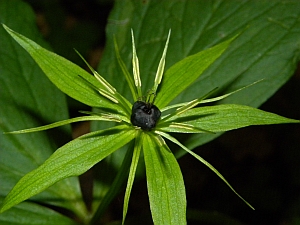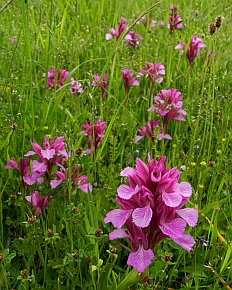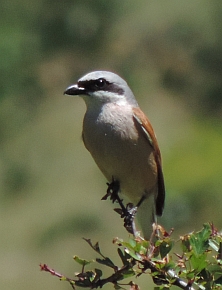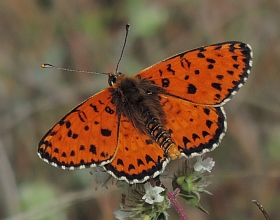 |
Picos de Europa:
a naturalist's paradise
- part 3
by Teresa Farino
Glorious haymeadows in the southern reaches of the Picos de Europa
 Herb Paris Paris quadrifolia © Teresa Farino Herb Paris Paris quadrifolia © Teresa Farino Between the foot of the cable car and the village of Espinama lies a wonderful tract of haymeadows, interspersed with beech forest, which harbours a quite different assemblage of plants and animals.This is one of the best places in the Picos de Europa to look for orchids, with early June bringing out a plethora of man, pyramidal, early marsh, Barton's, fragrant, lizard, bird's-nest, early purple, burnt, tongue and fly orchids, as well as dull, woodcock, early spider and sawfly ophrys.
The meadows themselves are colourful assemblages of kidney vetch (here with pink flowers), bloody crane's-bill, pale flax, musk-mallow, greater yellow-rattle (subspecies asturicus) and white asphodel, with other species of note including maiden pink, rock cinquefoil, round-headed rampion, the stemless, lilac-flowered 'thistle' Carduncellus mitissimus and round-headed leek, as well as sheets of  Pink Butterfly Orchids Pink Butterfly Orchids
Orchis papilionacea © Teresa Farino English irises from July onwards. Wetter areas teem with globeflower, marsh marigold, whorled lousewort, marsh ragwort and marsh hawk's-beard, while the woodland margins harbour astrantia, Pimpinella siifolia, bastard balm, spreading and rampion bellflowers, spiked rampion, spiked star-of-Bethlehem, martagon and Kerry lilies, Solomon's-seal, herb-Paris and Pyrenean squill.
The butterfly fauna of this corner of the Picos de Europa is stupendous in early summer, including grizzled and mallow skippers, both Iberian swallowtails,  Red-backed Shrike Lanius collurio © Teresa Farino black-veined white, Camberwell beauty, Glanville and knapweed fritillaries, Adonis, chalk-hill, turquoise, long-tailed, short-tailed, silver-studded and black-eyed blues, sooty and purple-edged coppers, blue-spot hairstreak and Duke of Burgundy fritillary. Roe deer and red-backed shrikes inhabit the edges of the meadows, wryneck, spotted flycatcher, black redstart, serin and cirl bunting abound in the villages of Pido and Espinama, and middle spotted woodpecker, tree pipit, Bonelli's warbler, marsh tit and short-toed treecreeper occupy the forest, although the beechwoods along the track leading north from Espinama towards the Puertos de Áliva are a better bet for black woodpecker, crested tit, red squirrel and pine marten. Red-backed Shrike Lanius collurio © Teresa Farino black-veined white, Camberwell beauty, Glanville and knapweed fritillaries, Adonis, chalk-hill, turquoise, long-tailed, short-tailed, silver-studded and black-eyed blues, sooty and purple-edged coppers, blue-spot hairstreak and Duke of Burgundy fritillary. Roe deer and red-backed shrikes inhabit the edges of the meadows, wryneck, spotted flycatcher, black redstart, serin and cirl bunting abound in the villages of Pido and Espinama, and middle spotted woodpecker, tree pipit, Bonelli's warbler, marsh tit and short-toed treecreeper occupy the forest, although the beechwoods along the track leading north from Espinama towards the Puertos de Áliva are a better bet for black woodpecker, crested tit, red squirrel and pine marten. Cork oak forest of Tolibes.
 Spotted Fritillary Melitaea didyma © Teresa Farino Spotted Fritillary Melitaea didyma © Teresa Farino
Close to Potes, in the southeastern corner of the Picos de Europa, lies an expanse of Mediterranean forest on acid shales, dominated by cork and western holm oaks sheltering an understorey of prickly juniper, osyris, turpentine tree, Mediterranean buckthorn, Cistus psilosepalus, strawberry-tree, Phillyrea latifolia, wild jasmine and Etruscan honeysuckle. Dry meadows here have pink butterfly, green-winged and Sicilian orchids plus Deptford pink, spotted rock-rose, field eryngo, wild clary and cone knapweed, while rocky outcrops host rock soapwort, Ruta angustifolia, French lavender, daisy-leaved toadflax, Helichrysum stoechas and - in spring - angel's-tears. The whole area is excellent for butterflies, including Spanish Swallowtail, Cleopatra, Provence Orange Tip, spotted fritillary and brown, purple, Spanish purple, blue-spot, ilex, false ilex and sloe hairstreaks, as well as sooty copper, black-eyed, Lang's short-tailed and Baton blues.
|